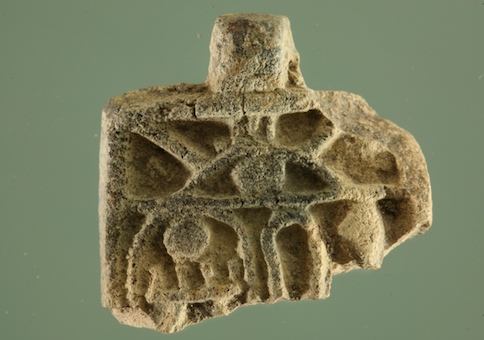A 12-year-old girl recently discovered a rare Egyptian amulet more than 3,200 years old while sifting through earth discarded from the Temple Mount in Jerusalem.
The amulet, which was recently deciphered by archeologists, bears the name of Egyptian King Thutmose III, a pharaoh who ruled Egypt during the 18th dynasty for about 54 years. Neshama Spielman, a 12-year-old from Jerusalem, discovered the amulet while participating in the Temple Mount Sifting Project at the Tzurim Valley National Park, according to a release circulated by project leaders Tuesday.
"Thutmose III was one of the most important pharaohs in Egypt’s New Kingdom and is credited with establishing the Egyptian imperial province in Canaan, conducting 17 military campaigns to Canaan and Syria, and defeating a coalition of Canaanite kings at the city of Megiddo in 1457 BCE," Dr. Gabriel Barkay, who cofounded and directs the Temple Mount Sifting Project, said of the discovery.
"Thutmose III referred to himself as ‘the one who has subdued a thousand cities,’ and it is known that for more than 300 years, during the Late Bronze Age, Canaan and the city state of Jerusalem were under Egyptian dominion, likely explaining the presence of this amulet in Jerusalem."
The announcement came just days before the eight-day celebration of the Passover festival.
"A discovery such as this is particularly symbolic at this time of year, with the Passover festival just a few days away, and represents greetings from the ancient past," Assaf Avraham, an archeologist from the Israel Nature and Parks Authority, said.
Spielman found the amulet while participating in the sifting project with family members.
The amulet, which is missing its bottom part, is shaped like a pendant and small, measuring 21 mm wide, 16 mm long, and 4 mm thick. Its top features a loop, indicating that the amulet was likely strung and hung on the neck. It is decorated with Egyptian hieroglyphics that bear the ancient pharaoh’s name.
This is the first instance that Thutmose’s name has been found on an amulet in Jerusalem, project leaders said. Archeologists have previously uncovered Egyptian scarabs bearing his name. Project leaders reconstructed the amulet using an identical pendant discovered nearly 40 years ago.
"The amulet can be reconstructed based upon the discovery of an identical pendant found in Nahal Iron in northern Israel, announced in 1978," Zachi Dvira, who also cofounded and directed the project, explained.
"Along with that pendant, which also bore the name of Thutmose III, was another amulet bearing the name of King Seti I, an Egyptian pharaoh who ruled Egypt during the late 14th-early 13th centuries BCE. This seems to indicate that both pendants date to the same period, namely the late 14th-early 13th century BCE."
Baruch Brandl, an Egyptologist with the Israel Antiquities Authority, produced the research on the amulet.
The Temple Mount Sifting Project was launched more than a decade ago in response to the illegal removal of tons of earth from the Temple Mount by the Islamic Waqf. Since, over 170,000 volunteers from Israel and other parts of the world have sifted through the earth.
Those involved in the project have been processing and studying the discoveries and preparing them for scientific publication. Over half a million artifacts turned up in the sifting process have yet to be processed and analyzed.
The project has turned up numerous rare findings, including a centuries-old potsherd bearing an apparent menorah engraving and an ancient seal from the time of King David.
The project was established under the auspices of Bar-Ilan University and is supported by the City of David Foundation and the Israel Nature and Parks Authority.
